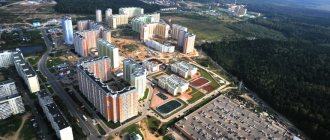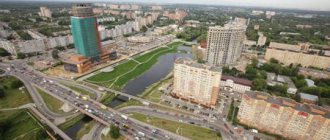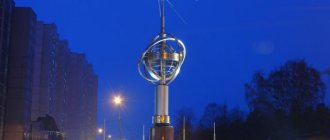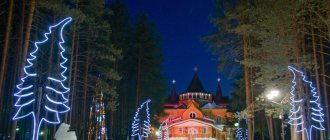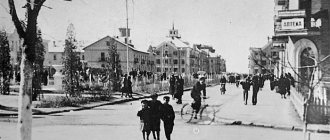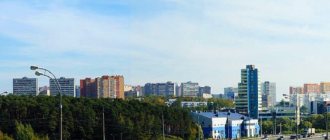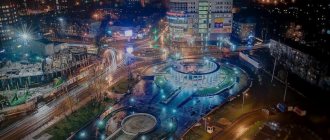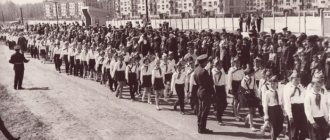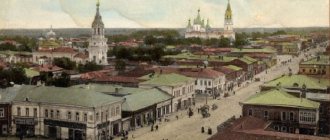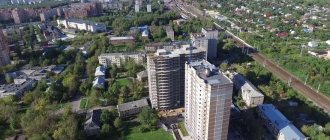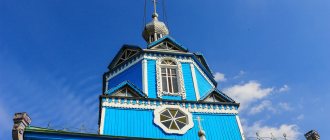Hello! The article tells about the small but wonderful town of Dzerzhinsky near Moscow, which stretches in the southeast from the Moscow ring road and the Moscow River to the Tomilino forest park.
My article talks about the history of the city, how it developed and grew, I also describe the sights, one of which is the ancient operating Nikolo-Ugreshsky monastery. It was founded at the behest of Grand Duke Dmitry Donskoy and is the calling card of the city.
You can learn about the monuments erected in the city in honor of the founder of the monastery and in honor of the founder of the city, its first mayor and many others. And also about the city’s sports life and sporting achievements.
HISTORY OF THE CITY OF DZERZHINSKY
According to legend, an icon of St. Nicholas the Wonderworker appeared to Grand Duke Dmitry Donskoy during the rest of his army during the campaign on the Kulikovo Field to battle the Tatar Khan Mamai. And the prince said: “This whole thing has sinned my heart,” which meant “All this has warmed my heart.”
After the victory on the Kulikovo field in 1380, Grand Duke Dmitry Donskoy ordered to erect a temple in honor of St. Nicholas the Pleasant and establish a monastic monastery on the site of the appearance of the icon.
During the reign of the Romanovs, the kings with their retinue and people went to pray at the Nikolo-Ugreshsky Monastery. Around the monastery there were the villages of Alekseevka, Kishkino, Denisyevo, Gremyachevo. But being close to Moscow, it was constantly subjected to raids and devastation by both the Tatar-Mongols and the French in 1812. But it was quickly restored.
However, after the kings moved to St. Petersburg, the monastery was abandoned for almost 130 years. In 1920 it was closed, and a children's labor commune for street children named after F.E. was created within its walls. Dzerzhinsky. There was even a film made on this topic, “A Start to Life.” Communards lived and worked in the premises of the dilapidated monastery.
Over time, a musical instrument factory, a fiberboard plant, an electrical plant, and the Spartak plant, which produced civilian products, appeared in the commune. And during the war, he fired powder charges for the famous Katyusha rocket launcher.
As production expanded, workers began to come from the Moscow region and other regions. They began to build fiberboard two- or three-story houses with communal apartments of three or four rooms and one common kitchen. These houses had no hot water or bathroom. Over time, a whole settlement of such fiberboard houses grew up.
And in 1938 the place received the status of a village. In 1947, on the basis of plant No. 512, the Research Institute of Jet Powders was created, which in 1966 grew into the Research Institute of Chemical Technology.
In 1971, the Lyubertsy scientific and production association LNPO “Soyuz” was formed, which will be transformed into the Federal Center for Dual Technologies FCDT “Soyuz”. And in 2002, to the Federal State Unitary Enterprise FSUE FCDT “Soyuz”.
After the construction of a large thermal power plant, CHPP 22, the village began to actively develop and be built.
In 1981, the village received the status of a city of regional subordination as part of the Lyubertsy district of the Moscow region. And in 1996, it was given the status of a city of regional subordination, a settlement of the municipal formation “Dzerzhinsky City District” - the only one in the Moscow region. This was the great merit of the first mayor.
Dzerzhinsky urban district
During the implementation of the Federal Law “On the General Principles of the Organization of Local Self-Government in the Russian Federation” (No. 131-FZ of October 6, 2003, entered into force on January 1, 2006), the system of municipalities was streamlined in the Moscow region. In 2004, the law of the Moscow Region “On granting the municipal formation “City of Dzerzhinsky of the Moscow Region” the status of an urban district ...” was adopted [21].
The Dzerzhinsky urban district includes one settlement - the city of Dzerzhinsky[21].
Geographical data
The area of the urban district is 1566 [1].
The municipality borders[21]:
- with the urban district of Kotelniki (in the north),
- with the urban settlement of Lyubertsy, Lyubertsy municipal district (in the northeast),
- with the urban district of Lytkarino (in the east),
- with the rural settlement of Molokovskoye, Leninsky municipal district (in the south),
- with the rural settlement of Razvilkovskoye, Leninsky municipal district (in the southwest),
- with the Kapotnya district of the SEAD of Moscow (in the west and north-west).
The Moscow River flows along the border of the urban district.
Authorities
The structure of local government bodies of the city is [22]:
- The Council of City Deputies
is an elected representative body of local self-government, which consists of 20 people elected according to a mixed system: 10 from party lists and 10 from single-mandate constituencies for a period of 5 years[23], - The head of the municipality
(
the head of the city
) is elected by the residents of the city for a period of 5 years [24], is also
the head of the administration
[24], - The city administration
is the executive and administrative body of local government[25], - Control body
- body of external financial control of the municipality[26], - The citywide meeting
is an advisory body whose participants are honorary citizens of the city, heads of enterprises, institutions and organizations, representatives of the city’s creative intelligentsia, deputies at various levels, and officials of the city administration[27].
The head of the city, the head of the administration is Vitaly Mikhailovich Panamorenko[28].
DZERZHINSKY CITY: ATTRACTIONS
In Dzerzhinsky, as in the whole country, the construction of four-story brick houses, the so-called “Khrushchevka”, was underway. In its historical part you can see a street of such houses, called Dzerzhinskaya Street.
In spring, the apple trees bloom so beautifully here, and there is such a scent, since the entire street is planted with apple trees. As in the song: “Apple trees in bloom are the creation of spring. Apple trees in bloom - love whirling.” But the city continues to grow and develop, and houses like this began to be built on modern streets.
Dzerzhinsky's calling card is the Nikolo-Ugreshsky Monastery
The Nikolo-Ugreshsky Monastery has become the calling card, the heart and soul of the city. Its revival began in 1990 after it was returned to the Russian Orthodox Church. There are 12 temples in the monastery, and after their reconstruction you can walk for hours and admire them.
The area is well-groomed, there is a beautiful pond. Both in summer and winter, black and white swans swim, a large number of ducks, and probably even more pigeons. Adults and children happily feed this army of birds.
The church shop has a large selection of crosses and icons. Herbal teas and other utensils are also sold. You can sit on benches, relax and admire the temples and landscape. It's beautiful and quiet here, so come, you won't regret it.
Monuments of the city of Dzerzhinsky
In honor of St. Nicholas the Wonderworker, protector of the Nikolo-Ugreshsky Monastery, a monument was erected behind the Palestine or Jerusalem Wall of the monastery. The sculpture of St. Nicholas the Wonderworker was made by V. Klykov.
For several centuries, Rus' was under the Tatar-Mongol yoke. The Tatars robbed the people, took women and children into captivity, and when Rus' became stronger, it decided to free itself from the hated yoke. According to legend, Grand Duke Dmitry Donskoy was blessed for this battle by the icon of St. Nicholas the Wonderworker.
The Nikolo-Ugreshsky Monastery is evidence that this legend is true. In honor of the founder of the Nikolo-Ugreshsky Monastery, a monument to Grand Duke Dmitry Donskoy was erected in the center of the city on the square named after the prince.
The “Eternal Flame” memorial in honor of those killed in the Second World War was installed in Victory Square. Next to the eternal flame there are 28 tombstones with the carved names of village residents who died in the Patriotic War. Of the several thousand who lived in the village, 700 soldiers died at that time, that is, the war brought grief to almost every family.
Residents of the city honor the memory of the fallen soldiers who defended us from the Nazi invaders at the cost of their lives, and there are always fresh flowers on the tombstones with names carved into the slabs.
The monument to the creators of the Russian missile shield is a complex of the legendary Katyusha, the Grad multiple launch rocket system and the Topol M ballistic missile.
These installations were created by numerous institutes, design bureaus and defense industry factories. A huge amount of work to create Russia’s missile shield was carried out by scientists, designers, engineers and workers of the Dzerzhinsky science city.
For this, many scientists, engineers and workers were awarded government orders and medals and State Prizes. Work to improve defense equipment continues at the present time at the Federal State Unitary Enterprise FSUE FTsDT “Soyuz”
The first mayor of the city of Dzerzhinsky, Viktor Dorkin, after graduating from the institute, got a job at the Scientific Research Institute of Chemical Technology, where he first worked as a simple engineer, and then reached the position of deputy head of the laboratory.
In 1990, he was elected chairman of the Dzerzhinsky City Council of People's Deputies, and in 1996, the people elected him mayor, and he led the city for 16 years. In 2006, late at night he left the building of a local television company, where, as usual, he answered questions from townspeople, and headed home; in the courtyard of the house, the killer shot him 16 times.
The killer and his partner were arrested and convicted. However, the customer managed to escape, and he was arrested only 10 years later upon his return to Russia. There is a monument to the first mayor of the city opposite the city hall.
Economy
The city-forming enterprises in Dzerzhinsky are:
- CHPP-22 - branch of Mosenergo;
- FCDT Soyuz is the main developer of solid rocket fuel in Russia;
- MKB "Horizon";
- Dzerzhinsky industrial and construction branch of OJSC "SPK Mosenergostroy"; K: Wikipedia: Articles without sources (type: not specified) [ source not specified 3812 days
]
Also in Dzerzhinsky there are over 700 more institutions, enterprises and organizations of various forms of ownership. For example, the second car recycling plant in the Moscow region recently opened.
SPORTS AND RECREATION IN MY CITY DZERZHINSKY
There is a stadium here with two football fields, which in winter are used as a skating rink and then some people skate and others play hockey. The stadium has a whole range of sports equipment. There are various sports sections for adults and children. Olympic ski champion Nikita Kryukov grew up here.
The stadium has several closed buildings, where in the winter they practice basketball and tennis (children's sports school), and in the summer they play football on beautiful fields and hold matches with teams from other cities. Anyone can play basketball on the court or tennis on the adjacent field.
On the shore of the quarry there is the Freestyle ski center. There are two ski slopes, four lifts, and an illuminated track. Children can go down on cheesecakes. Adults here study with a ski instructor, and children take classes at a ski school. Snowmobiles and ATVs are available for rent. And there is a place to park vehicles, parking is free.
You can also visit a reindeer farm and ride Nordic dogs. Animals communicate friendly with people. You can go to the reindeer, they are allowed to feed and pet them. The guide shows the yurt, clothes and household items of the peoples of the north - all handmade.
Transport
See also: Dzerzhinsky bus
Pier on the river Moscow is operational and used by pleasure ships of the Capital Shipping Company, including from the Klenovy Boulevard pier (next to the Kolomenskaya metro station) to the pier in Dzerzhinsky - an excursion route to the Nikolo-Ugreshsky Monastery.
Within the city limits there is a former station and platform “Dzerzhinskaya”, the railway line from the station “Panki” - Dzerzhinskaya is now closed to passenger traffic. On September 21, 2015, the Kotelniki metro station on the Tagansko-Krasnopresnenskaya line opened a few kilometers from the city. In addition, by bus route No. 1063 of the Reis motor transport enterprise you can get to the Alma-Atinskaya metro station on the Zamoskvoretskaya line[29].
Communications and media
The following operators provide communication services in the city:
- "Virgin Connect" (formerly LLC "Darling-TIN")
- "Ugresha Network"
- LLC "Dzinet"
- LLC "AVK-WELLCOM"
- JSC "Montazh"
- NP “Communication Without Borders” (since 2010 merged with “Ugresha Network”)
- R.I.M.S.
- Eurasia Telecom Ru
- Rostelecom
Cable television "Ugresha". Since January 1991, the newspaper “Ugreshskie Vesti” has been published.
Mobile operators:
- Beeline;
- Megaphone;
- MTS;
- Sky Link.
- TELE2
Links
| External links in this article may not comply with Wikipedia guidelines. You can improve this article by removing unnecessary or inappropriate links. |
Areas: Dmitry Donskoy • St. Nicholas Other streets: Alekseevskaya • Bondareva • Denisyevsky proezd • Zavodskaya • Zelenaya • ZIL Quarry • Lazurina Boulevard • Lermontov • Ovinovka • Poklonnaya • Pushkin proezd • Sadovaya • Severny proezd • Stroiteley • Stroygorodok • Trudkommuny • Shama • Shkolnaya • Energetikov • Yuzhny proezd Moscow region Urban districts Balashikha • Bronnitsy • Vlasikha (ZATO) • Voskhod (ZATO) • Dzerzhinsky • Dolgoprudny • Domodedovo • Dubna • Yegoryevsk • Zhukovsky • Zvenigorod • Star City (ZATO) • Ivanteevka • Kashira • Kolomna • Korolev • Kotelniki • Krasnoarmeysk • Krasnoznamensk (ZATO) • Lobnya • Losino-Petrovsky • Lytkarino • Molodezhny (ZATO) • Mytishchi • Ozyory • Orekhovo-Zuevo • Podolsk • Protvino • Pushchino • Reutov • Roshal • Serebryanye Prudy • Serpukhov • Fryazino • Khimki • Chernogolovka • Elektrogorsk • Elektrostal • Shakhovskaya
